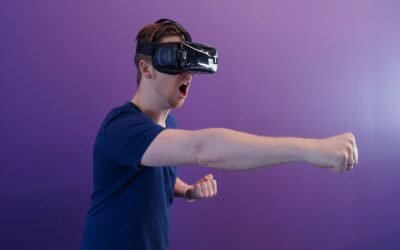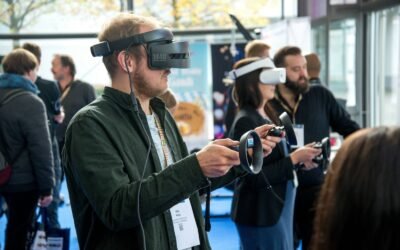Augmented Reality (AR) is a technology that overlays digital information, such as images, videos, or 3D models, onto the real-world environment to enhance the user’s perception and interaction. It works by utilizing devices equipped with cameras, sensors, and processing power, such as smartphones or AR glasses. The device captures the real-world view and combines it with virtual content, which is then superimposed onto the user’s view, either through the device’s screen or transparent display in the case of AR glasses. This blending of real and virtual elements creates an augmented view where the user can see and interact with both the physical and digital worlds simultaneously, providing an immersive and interactive experience.
Mobile AR applications are widely used and accessible through smartphones or tablets. These applications utilize the device’s camera, sensors, and processing power to create an interactive AR experience. Here are some of the most common implementations and use cases of AR in mobile applications:
- Gaming
AR gaming is a popular and engaging use case. It involves overlaying virtual objects, characters, or game elements onto the real-world environment, allowing users to interact with them. Pokemon Go is a notable example of an AR game that gained widespread popularity. - Navigation and Wayfinding
AR can be used to provide visual directions and guidance. By using GPS, compass, and camera, AR applications can superimpose digital directions, markers, or arrows onto the real world, helping users navigate through unfamiliar places or find specific points of interest. - Retail and E-commerce
AR is revolutionizing the shopping experience. Customers can virtually try on clothing, accessories, or cosmetics using AR-enabled apps. It allows users to see how a product would look on them without physically trying it on, enhancing the decision-making process and reducing returns. - Education and Training
AR has immense potential in education by providing interactive and immersive learning experiences. AR apps can overlay educational content, such as 3D models, animations, or information, onto textbooks, worksheets, or real-life objects. This enhances understanding and engagement in subjects like science, history, or anatomy. - Advertising and Marketing
AR is increasingly used in advertising campaigns to create interactive and memorable experiences. Brands can use AR to superimpose virtual objects, characters, or branding materials into real-world environments, allowing users to engage with their products in unique ways. - Real Estate
AR is transforming the way real estate is showcased. AR apps can overlay virtual furniture, interior designs, or even architectural models onto the actual space, giving potential buyers a realistic preview of how a property would look after customization. - Social Media and Filters
AR filters have become immensely popular on social media platforms like Instagram and Snapchat. These filters add virtual elements, effects, or animations to a user’s face or environment, enabling them to take fun and creative photos or videos to share with friends and followers. - Industrial Maintenance and Repair
AR can assist technicians in performing complex maintenance or repair tasks. By wearing AR glasses or using handheld devices, workers can receive real-time visual instructions, overlaying relevant information or step-by-step guides onto the equipment they are working on. - Training and Simulations
AR is used for training in various industries, including aviation, military, and healthcare. It provides realistic simulations and scenarios where trainees can practice and learn in a safe and controlled environment. For example, surgeons can use AR to practice complex procedures before performing them on actual patients. - Virtual Try-On
AR is utilized in the beauty and fashion industry for virtual try-on experiences. Users can see how different makeup products, hairstyles, or clothing items would look on them in real-time using their device’s camera. - Sports and Fitness
AR is used to enhance sports training and fitness activities. It can overlay performance metrics, virtual opponents, or visual guides onto the real environment to assist athletes in improving their skills or maintaining proper form during workouts. - Remote Collaboration and Support
AR enables remote collaboration by overlaying virtual elements on a live video feed. It allows teams to share information, provide guidance, and solve problems remotely. For example, an expert can guide a field technician by marking instructions or drawing annotations directly onto the technician’s view. - Tourist Guides and Travel
AR apps can provide tourists with real-time information about landmarks, historical sites, or points of interest as they explore a new city. It can overlay directions, historical facts, or multimedia content onto the camera view, enhancing the travel experience. - Health and Wellness
AR has applications in healthcare, including medical education, patient education, and rehabilitation. It can be used to visualize anatomical structures, overlay diagnostic information, or guide patients through exercises and therapy routines. - Automotive Industry
AR is utilized in the automotive sector for tasks such as vehicle design, prototyping, and assembly. It enables engineers and designers to visualize and assess different components, layouts, or safety features in a virtual setting. - Remote Assistance and Field Support
AR can be used to provide real-time remote assistance to field technicians or workers in challenging environments. By wearing AR glasses or using mobile devices, technicians can collaborate with experts who can overlay instructions, diagrams, or annotations onto their live video feed. - Emergency Response and Disaster Management
AR can assist emergency responders in disaster situations. It can provide vital information such as building layouts, escape routes, or hazardous areas overlaid onto the real environment, helping responders navigate and make informed decisions quickly. - Product Prototyping and Visualization: AR is used in product design and prototyping to visualize and assess 3D models in a real-world context. It allows designers to interact with virtual prototypes, test different variations, and gather feedback before physical production.
- Construction and Architecture Site Planning
AR can assist in visualizing architectural plans and construction projects on-site. It allows stakeholders to overlay digital models, plans, or measurements onto the real environment, aiding in site planning, coordination, and avoiding potential conflicts. - Cultural Events and Entertainment
AR is used to enhance live events, concerts, or performances. It can overlay digital effects, animations, or interactive elements onto the stage or venue, creating immersive and captivating experiences for the audience. - Virtual Museums and Exhibitions
AR enables the creation of virtual museums and exhibitions accessible remotely. Users can explore and interact with digital replicas of artifacts, artworks, or historical sites from the comfort of their own homes. - Language Translation and Learning
AR applications can translate text in real-time using the device’s camera, helping users understand signs, menus, or written content in different languages. It can also be used for language learning by overlaying translations, pronunciation guides, or interactive exercises onto printed material. - Environmental and Sustainability Awareness
AR can be used to raise awareness about environmental issues and sustainability. It can overlay information, statistics, or interactive visuals onto physical objects or spaces, educating users about the impact of their actions and promoting sustainable behaviors. - Art and Creative Expression
AR allows artists and creators to merge the digital and physical worlds. It can be used to showcase interactive and immersive artworks, sculptures, or installations that respond to user interactions or change over time. - Fashion Styling and Personalization
AR can assist in fashion styling by suggesting outfit combinations, providing fashion recommendations, or creating virtual fitting rooms where users can see how different clothing items would look on them.
These additional use cases demonstrate the versatility and potential of AR technology across various industries and domains. The applications of AR continue to expand as technology advances and creativity fuels innovation.







